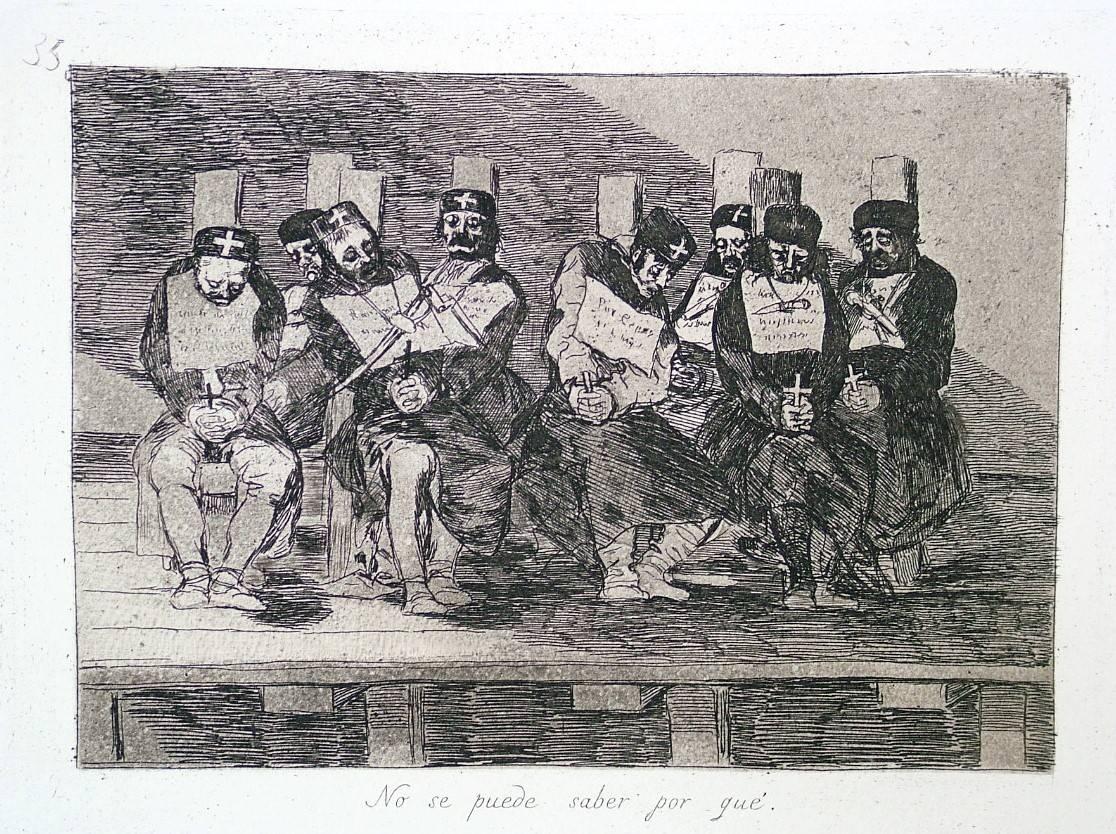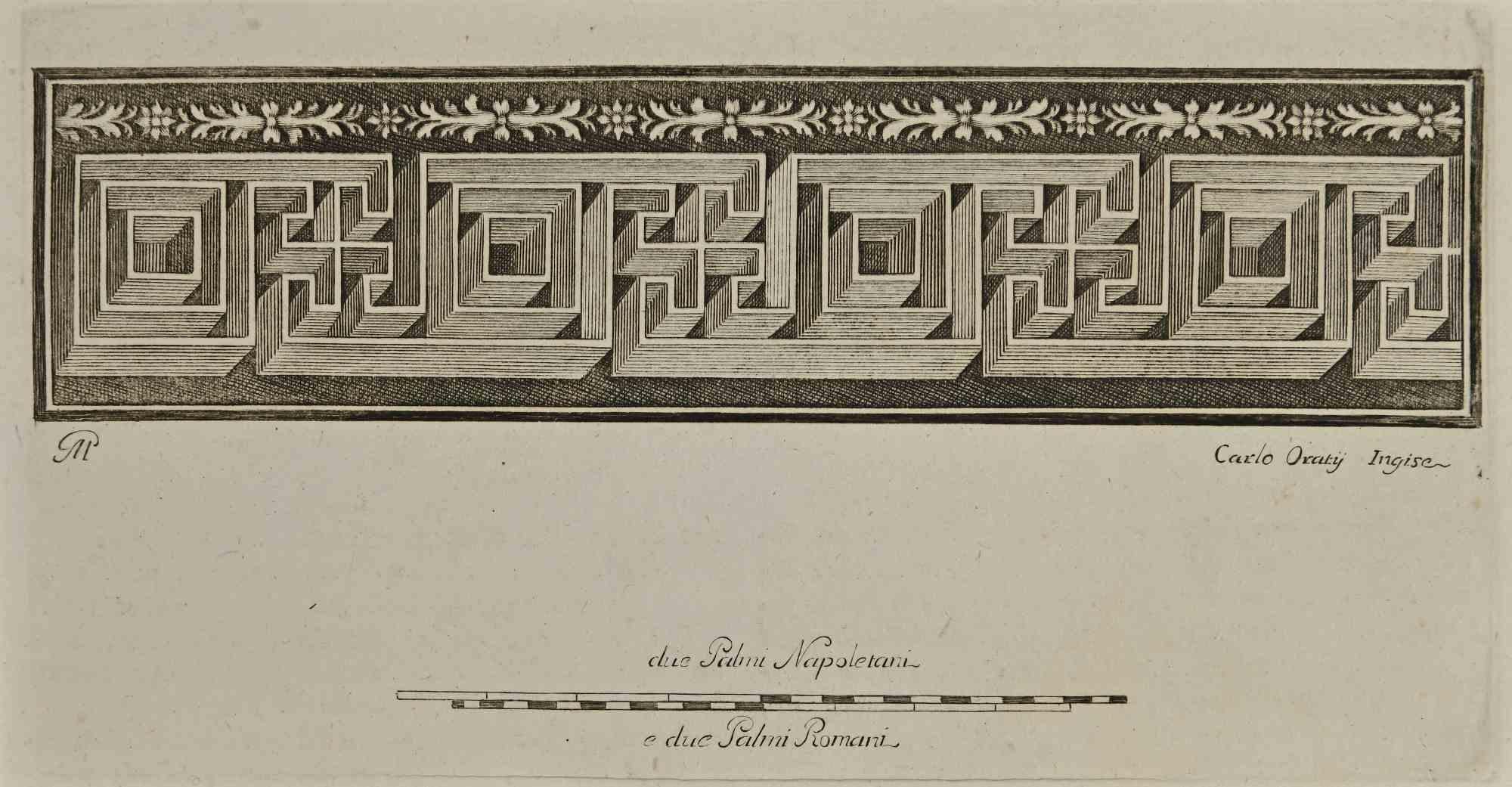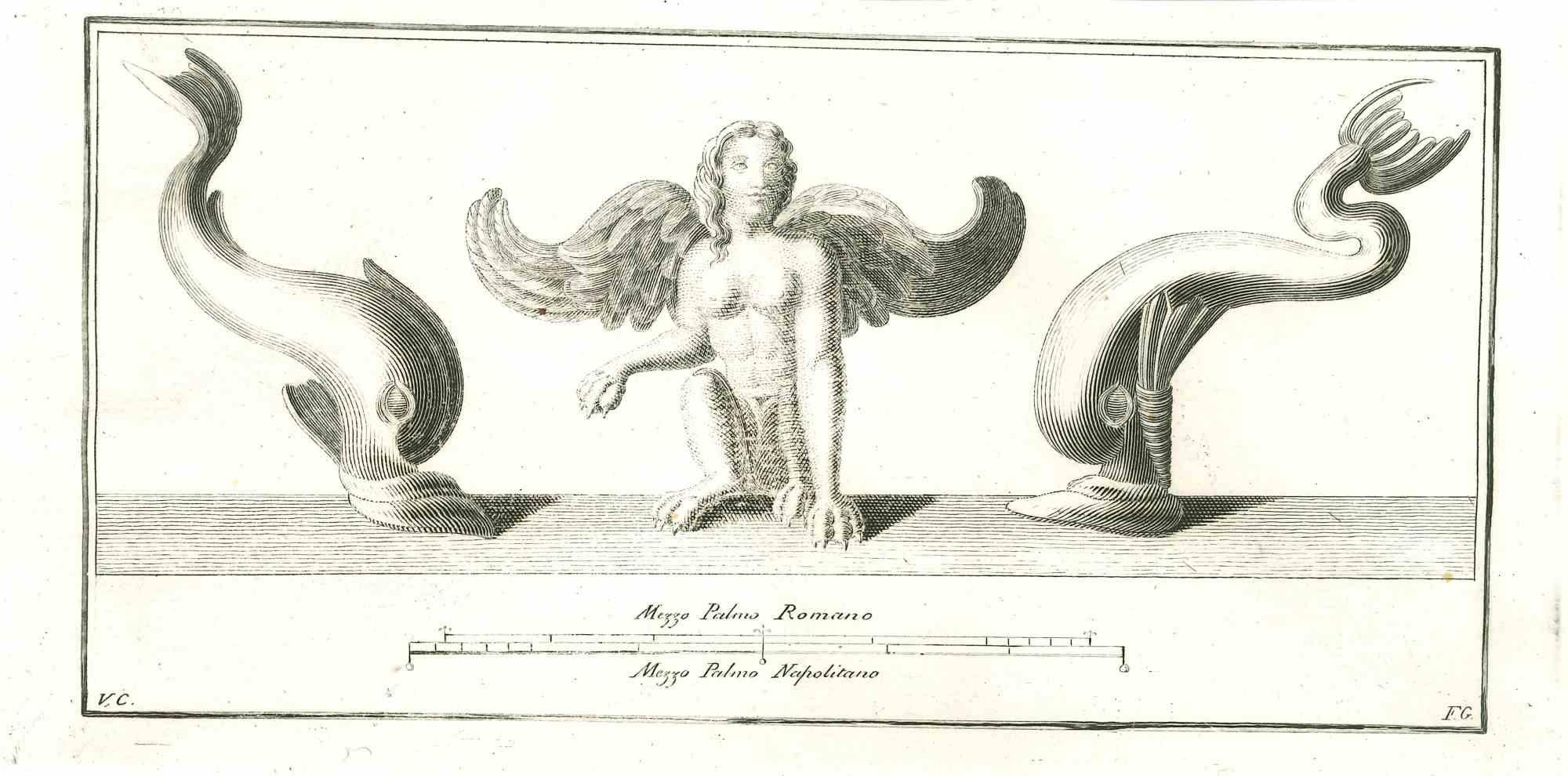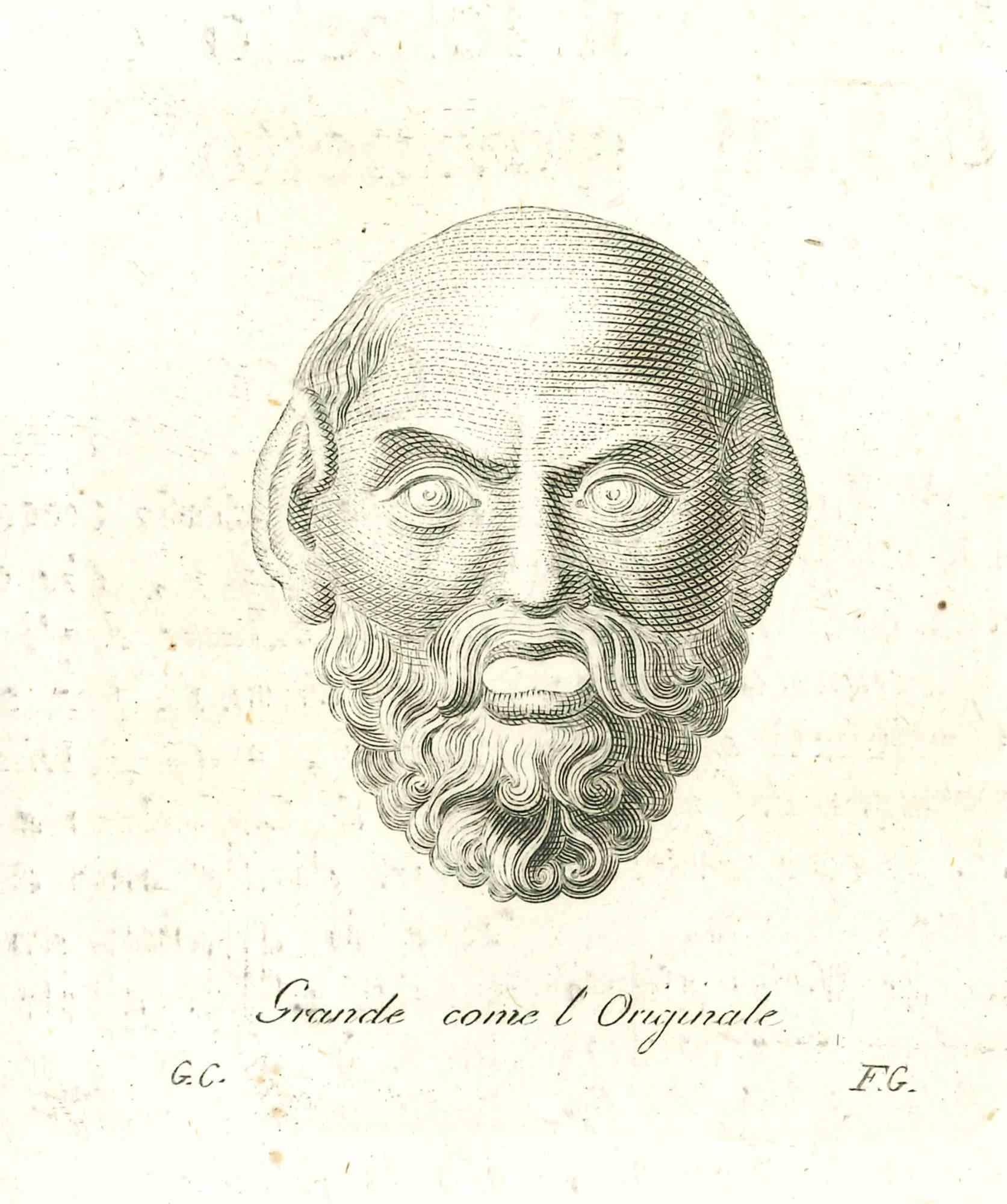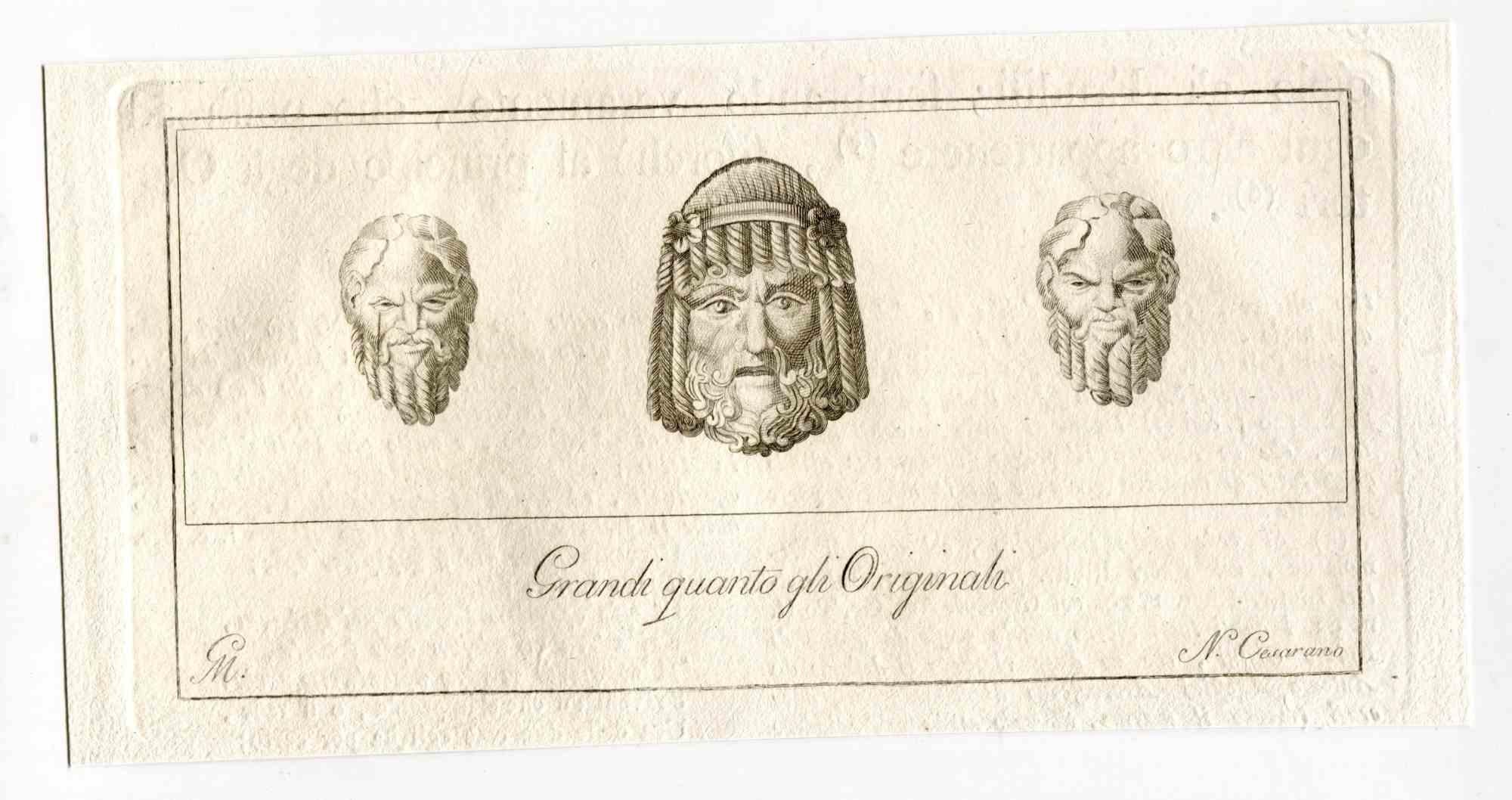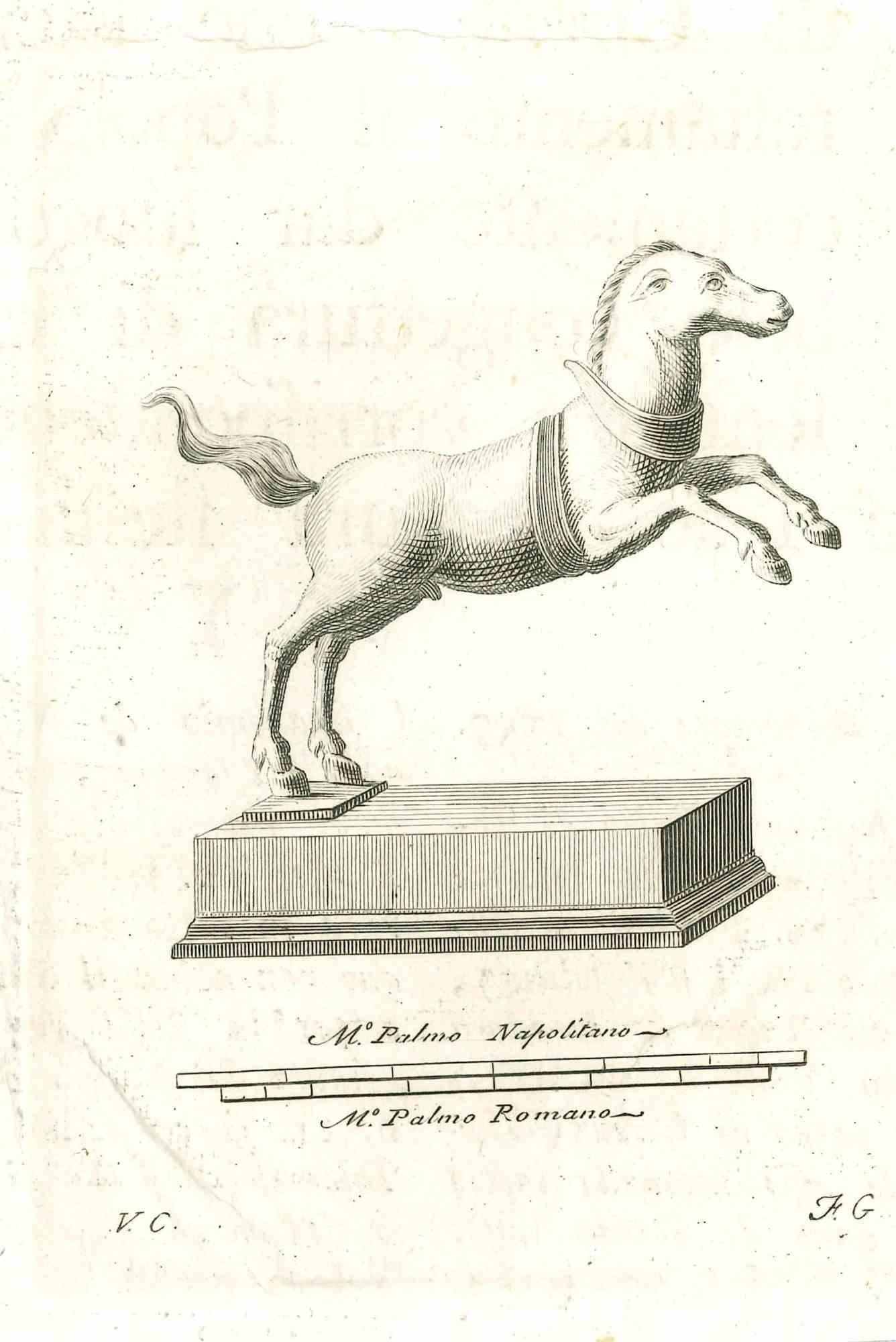Objekte ähnlich wie Antike römische Schutzköpfe – Original-Radierung von Vincenzo Campana, 18. Jahrhundert
Möchten Sie mehr Bilder oder Videos?
Zusätzliche Bilder oder Videos von dem*der Anbieter*in anfordern
1 von 2
Vincenzo CampanaAntike römische Schutzköpfe – Original-Radierung von Vincenzo Campana, 18. Jahrhundert18th Century
18th Century
Angaben zum Objekt
Ancient Roman Protecting Heads, from the series "Antiquities of Herculaneum", is an original etching on paper realized by Vincenzo Campana in the 18th century.
Signed on the plate.
Guter Zustand.
The etching belongs to the print suite “Antiquities of Herculaneum Exposed” (original title: “Le Antichità di Ercolano Esposte”), an eight-volume volume of engravings of the finds from the excavation of the ruins of Herculaneum in the Kingdom of Naples (now Campania, Italy).
It was published between 1757 and 1792 by the Regia Stamperia, and copies were delivered to selected recipients across Europe.
Despite the title, the Antiquity of Herculaneum shows objects from all the excavations undertaken by the Bourbons in the Gulf of Naples. These include Pompeii, Stabia and two sites of Herculaneum: Resina and Portici.
The Bourbon King Carlo appointed fifteen scholars creating a new “Herculaneum Academy” to study the artifacts and publish the results of the archaeological excavations of the sites.
The engravings are of high quality and the accompanying text shows a large scholarship.
They were realized by 25 prominent artists involved by the King to prepare drawings and engravings on the finds, among which we can find Giovanni Elia Morghen, Carlo Nolli, Luigi Vanvitelli and Giovanni Battista Casanova.
The “Antiquities” was designed more to amaze readers with the quality of the objects in the collection of the King of Naples than to be used in research., following and increasing the interest of 18th century society for the classical culture and Art in particular.
Through the exaltation of the classical concept of proportions and harmony, the book was of inspiration to the neoclassical movement in Europe, giving artists and decorators access to a huge shop of Hellenistic motifs.
Ref.:
National Gallery (Washington), Mark J. Millard Architectural, IV (2000), no. 1;
L. Garcia y Garcia, Nova bibliotheca pompeiana (2 v., 1998);
Royal Institute of British Architects, British Architectural Library ... Early printed books, 1 (1994), no. 112.
U. Pannuti, 'Incisori e disegnatori della Stamperia Reale di Napoli nel secolo XVIII: la pubblicazione delle Antichità di Ercolano', in Xenia antiqua, 9 (2000), p. 151-178;
V. Trombetta, 'L'edizione de Le Antichità di Ercolano esposte' in Rendiconti dell'Accademia di Archeologia, lettere e belle arti di Napoli , 59 (1984), p.151-172.
- Schöpfer*in:
- Entstehungsjahr:18th Century
- Maße:Höhe: 12 cm (4,73 in)Breite: 25 cm (9,85 in)Tiefe: 1 mm (0,04 in)
- Medium:
- Bewegung und Stil:
- Zeitalter:
- Rahmen:Rahmenoptionen verfügbar
- Zustand:Insurance may be requested by customers as additional service, contact us for more information.
- Galeriestandort:Roma, IT
- Referenznummer:
Informationen zu dem*der Anbieter*in
4,9
Platin-Anbieter*in
Diese von Expert*innen geprüften Anbieter*innen sind die erfahrensten Anbieter*innen von 1stDibs und werden von unseren Kund*innen am besten bewertet.
1stDibs-Anbieter*in seit 2017
6.806 Verkäufe auf 1stDibs
Typische Antwortzeit: 3 Stunde
- VersandAngebot wird abgerufen …Versand von: Grasse, Frankreich
- RückgabebedingungenDie Rückgabe dieses Objekts kann innerhalb von 14 Tagen ab Lieferung veranlasst werden.
Einige Inhalte dieser Seite wurden automatisch übersetzt. Daher kann 1stDibs nicht die Richtigkeit der Übersetzungen garantieren. Englisch ist die Standardsprache dieser Website.
Mehr von diesem*dieser Anbieter*inAlle anzeigen
- Antikes römisches Fresco-Herculaneum – Radierung von Carlo Oratij – 18. JahrhundertAntikes römisches Fresko aus der Serie "Antiquitäten von Herculaneum", ist eine Radierung auf Papier von Carlo Oratij aus dem 18. Jahrhundert. Signiert auf der Platte. Gute Bedingu...Kategorie
Spätes 18. Jahrhundert, Alte Meister, Figurative Drucke
MaterialienRadierung
- Antike Exemplare des Herculaneum Exposed- Original-Radierung - 18. JahrhundertAntiquities of Herculaneum Exposed, original etching from the end of the 18th century, made by Various Old Masters. Guter Zustand. The etching belongs to the print-series Antiqui...Kategorie
Spätes 18. Jahrhundert, Alte Meister, Figurative Drucke
MaterialienRadierung
- Antikes römisches Relief - Original-Radierung - 18. JahrhundertAncient Roman Relief, aus der Serie "Antiquities of Herculaneum", ist eine Originalradierung auf Papier, die von einem anonymen Artista im 18. Signiert auf der Platte unten links. Gu...Kategorie
Spätes 18. Jahrhundert, Alte Meister, Figurative Drucke
MaterialienRadierung
- Antikes römisches Fresco - Original-Radierung - 18. JahrhundertAntikes römisches Fresko aus der Serie "Altertümer von Herculaneum", ist eine Originalradierung auf Papier, die von einem Unbekannten im 18. Signiert auf der Platte. Guter Zustand ...Kategorie
18. Jahrhundert, Alte Meister, Figurative Drucke
MaterialienRadierung
- Antike römische Statue - Original-Radierung von Vincenzo Campana - 18. JahrhundertVon Vincenzo CampanaAntike römische Statue, aus der Serie "Altertümer von Herculaneum", ist eine Originalradierung auf Papier, die von Vincenzo Campana im 18. Signiert auf der Platte unten links. Gute...Kategorie
Spätes 18. Jahrhundert, Alte Meister, Figurative Drucke
MaterialienRadierung
- Antike römische Fresco-/Marineschlacht – Original-Radierung von V. Aloja – 18. JahrhundertVon Vincenzo AlojaAntikes römisches Fresko / Seeschlacht aus der Serie "Altertümer von Herculaneum", ist eine Originalradierung auf Papier, die von Vincenzo Aloja im 18. Signiert auf der Platte. Gut...Kategorie
18. Jahrhundert, Alte Meister, Figurative Drucke
MaterialienRadierung
Das könnte Ihnen auch gefallen
- The Can't Tell Why - Beweise für die Katastrophen des KriegesVon Francisco GoyaFrancisco José de Goya y Lucientes (1746 Fuendetodos - Bordeaux 1828), No se puede saber por qué - Man kann nicht sagen, warum ca. 1808-1814, Radierung, brünierte Aquatinta, Ka...Kategorie
1810er, Alte Meister, Figurative Drucke
MaterialienKaltnadelradierung, Radierung, Aquatinta
- Jan Uytenbogaert, Der GoldwäscherVon Rembrandt van RijnBartsch 281, Hind 167 iii/III, Nowell-Usticke 281, iii/III. Schöner Abdruck mit Grat, wie er von Baillie 1792 retuschiert wurde. Mit einem nicht identifizierten Sammlerstempel, verso.Kategorie
17. Jahrhundert, Alte Meister, Figurative Drucke
MaterialienKaltnadelradierung, Radierung
- Türkisches Funeral.Von Marius BauerEin türkisches Begräbnis. 1889. Radierung. Wisselingh 60. 3 3/4 x 5 1/2 (Blatt 8 3/4 x 11 7/8). Auflage 100, Nr. 9. Ein reich getuschter Abdruck auf Straßburger Creme Bütten gedruc...Kategorie
Spätes 19. Jahrhundert, Alte Meister, Figurative Drucke
MaterialienRadierung
- Fairy Tale, ein MärchenVon Marius BauerEin Märchen. 1897. Radierung. Wisselingh 18. 2 3/4 x 4 3/8 (Blatt 5 9/16 x 7 5/8). Ausgabe 100, Nr. 51. Ein reicher Abdruck auf cremefarbenem Büttenpapier. Mit Bleistift signiert und...Kategorie
Spätes 19. Jahrhundert, Alte Meister, Figurative Drucke
MaterialienRadierung
- Street in SmyrnaVon Marius BauerStraße in Smyrna. 1889. Radierung. Wisselingh 34. 7 x 5 1/4 (Blatt 12 7/8 x 8 7/8), Auflage 100, Nummer 49. Ein reicher, tonaler Abdruck, gedruckt auf cremefarbenem Straßburger Bütte...Kategorie
Spätes 19. Jahrhundert, Alte Meister, Figurative Drucke
MaterialienKaltnadelradierung, Radierung
- Bellos Consejos (Wundervolle Ratschläge)Von Francisco GoyaEin Abdruck aus der 1. Ausgabe von 1799, der einzigen Ausgabe, die zu Goyas Lebzeiten veröffentlicht wurde. Referenzen: Los Caprichos Tafel 15; Delteil 52; Harris 50 III.1 Übe...Kategorie
18. Jahrhundert und früher, Alte Meister, Figurative Drucke
MaterialienRadierung, Aquatinta
